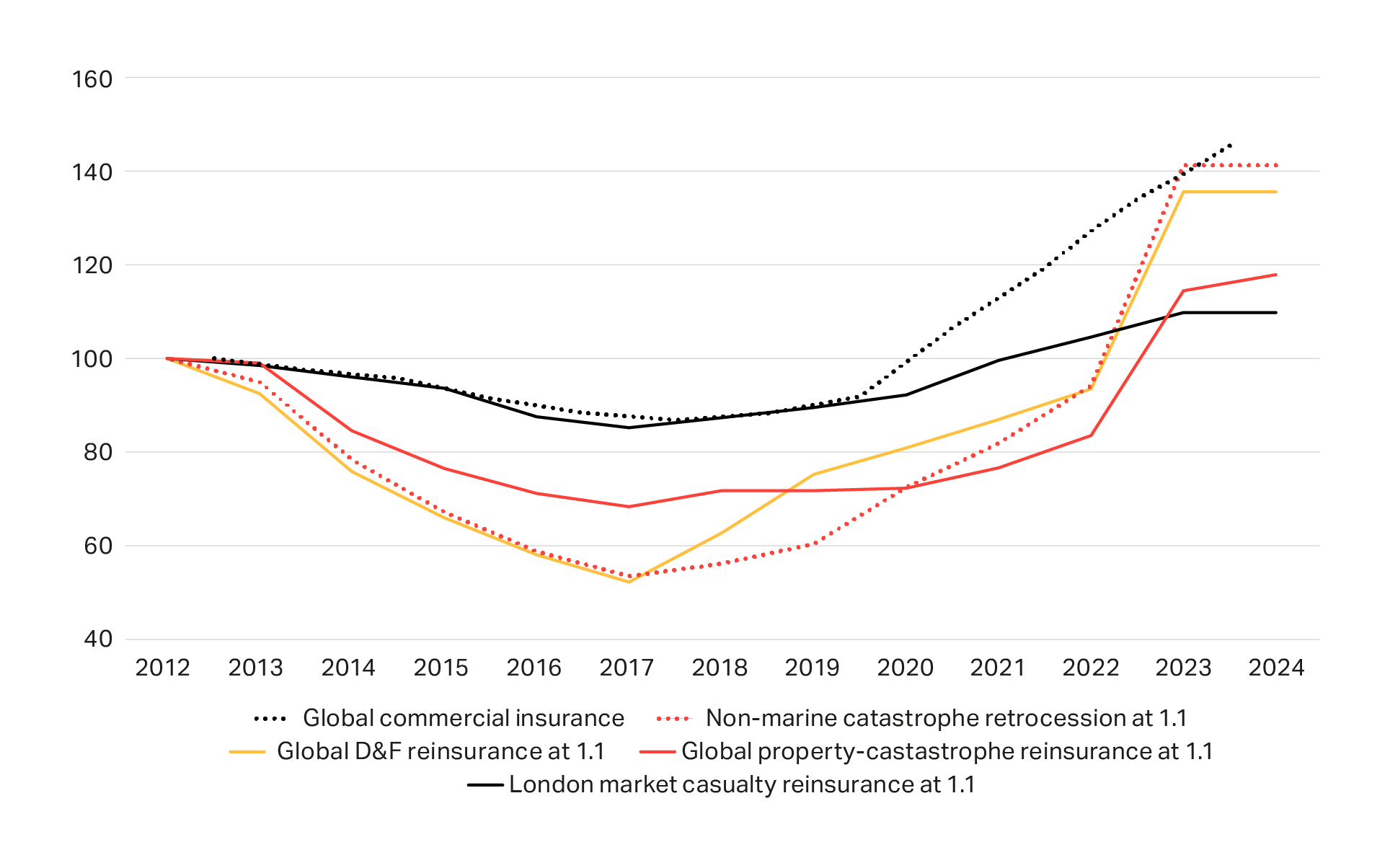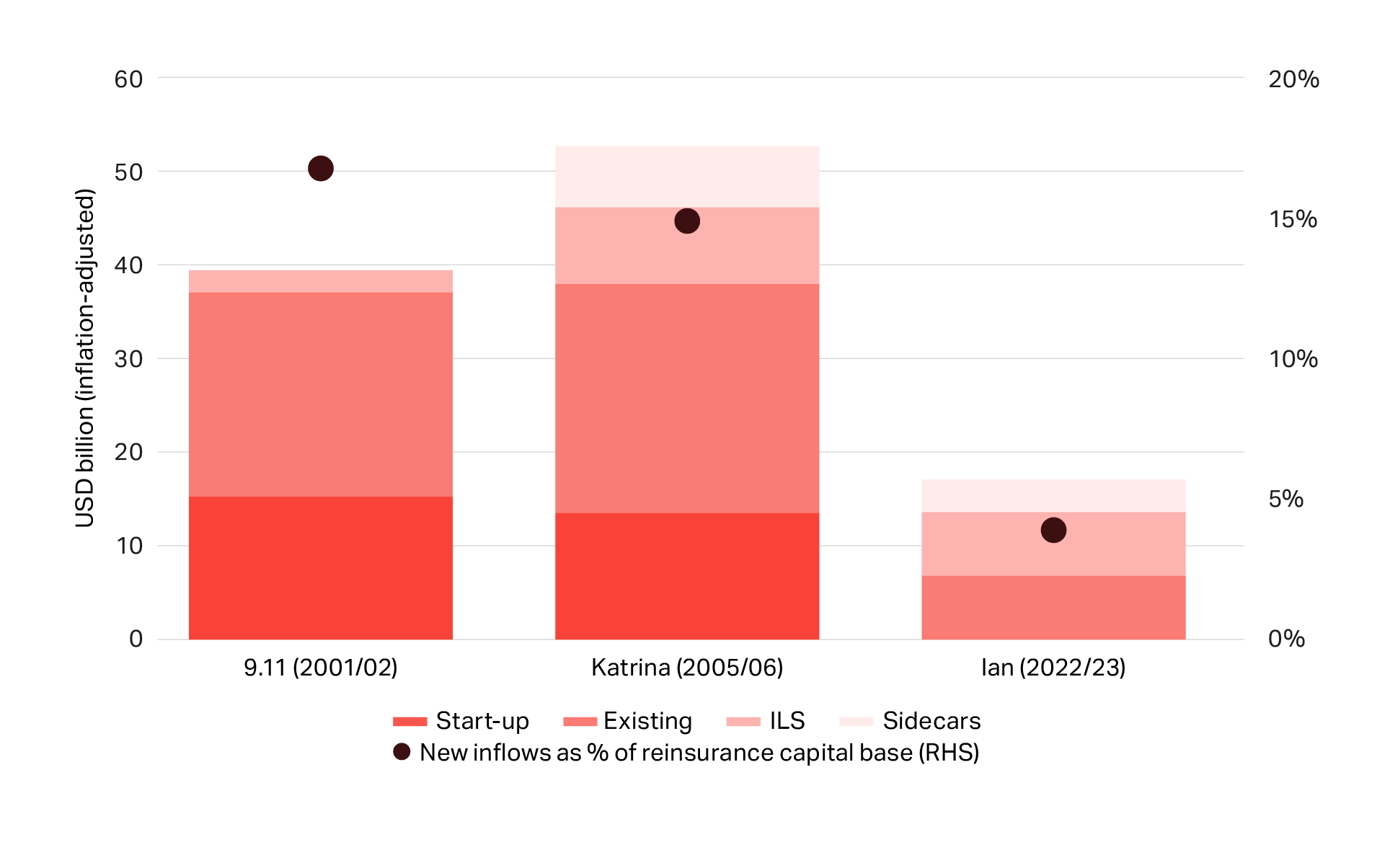Howden’s renewal report at 1.1.2024: A New World
This article was published in January 2024. Read the 2025 report here.
The market is adjusting to a period of extraordinary cyclical and structural change
- Stable reinsurance renewals observed at 1 January 2024 due to more favourable supply dynamics
- This yielded stable risk-adjusted rate movements at 1 January 2024: retrocession – flat, global direct and facultative – flat, global property-catastrophe – +3%, London Market casualty – flat%
London 2 January 2024 – Howden releases its annual market report. Relative stability has returned to the (re)insurance market following a period of turbulence that culminated last year in what Howden termed The Great Realignment.[1] Market conditions have improved in the following 12 months, with supply more than sufficient to meet demand.
Nuanced conditions across the (re)insurance market reflect new macroeconomic and geopolitical realities and re-set loss expectations. Improved supply dynamics nevertheless suggests sentiment is now shifting as pricing momentum across different areas of the market drives improved performance and increased appetite to deploy capacity.
Watch Julian Alovisi, Head of Research, outline the key topics covered in the report, and read on for some highlights. You can download the full report at the end of this article.
Figure 1: Howden pricing index for primary, reinsurance and retrocession markets – 2012 to 2024 (Source: NOVA)

1 January 2024 reinsurance renewals
Renewals took place in an environment of more favourable supply dynamics, but also underwriting discipline. The result was a relatively stable and orderly renewal, with supply more than sufficient to meet increased demand. Risk-adjusted pricing saw flat changes overall. Any significant variation by territory or line of business was informed by loss experience. Capacity for frequency protection was once again at a premium, but competition further up programmes brought better outcomes. Terms and the scope of coverage were a core focus in 2024, which resulted in improved concurrency overall. Capital inflows supported more favourable market conditions.
Retrocession
The absence of major losses in 2023, favourable development for Hurricane Ian and increased capital inflows towards the end of the year yielded stable retrocession renewals at 1 January 2024. Whereas last year’s dislocated renewal reflected trapped capital and long-standing investor fatigue, improved performance in 2023 put pressure on price and signings.
Risk-adjusted retrocession catastrophe excess-of-loss rates-on-line were flat at 1 January 2024. Low-attaching occurrence layers and aggregate covers continued to suffer from a lack of supply, whilst strong competition further up programmes resulted in favourable outcomes for cedents, with modest risk-adjusted reductions achieved in certain instances. Strong investor appetite saw catastrophe bond pricing fall in the 10% range and remain at attractive levels for both buyers and sellers.
Global direct and facultative
The D&F reinsurance market once again supported clients renewing programmes at 1 January following a year of strong growth and favourable loss experience, including reduced loss expectations for Hurricane Ian. Demand for D&F catastrophe cover remained robust, driven by higher rates / premium on original business, higher insured valuations on original business and the attendant need for additional limits.
Following a major pricing correction at last year’s corresponding renewal, rate movement in 2024 was flat on a risk-adjusted basis. A cumulative increase of 160% since 2017 keeps pricing levels close to where they were last year and above those recorded in the aftermath of Hurricane Katrina. The underlying market has benefitted from similar pricing tailwinds during this time.
Property-catastrophe
Global risk-adjusted global property-catastrophe reinsurance rates-on-line rose by an average of 3% at 1 January 2024.2 This was down considerably on the +37% recorded in 2023. Increased appetite from most markets meant supply was able to meet demand to a degree that was lacking last year. The rebound in the ILS market was an important factor as competition increased for higher-attaching layers, which in turn encouraged new sponsors to enter the market. Terms and coverage scope remained largely stable, although there was a notable shift towards concurrency.
Insured catastrophe losses exceeded USD 100 billion for the fourth straight year in 2023, indicating an elevated baseline for loss expectations. The lion’s share of insured losses were borne by insurers following reinsurers’ structural retreat from frequency risks through 2023’s renewal cycle.
Loss experience and inflation shaped European property-catastrophe renewals. More favourable supply dynamics helped to moderate overall pricing increases to low- to mid-single-digits. Efforts to restructure programmes, begun in earnest during renewals last year, were extended at 1 January 2024 to countries that escaped adjustments and made sizeable reinsurance recoveries in 2023, including Italy, Turkey and Slovenia. Double-digit risk-adjusted pricing increases were typical in these territories. Capacity was nevertheless sufficient to see deals over the line.
U.S. renewals at 1 January 2024 reflected improved supply dynamics, with reinsures willing to support terms and pricing levels broadly aligned to those established during last year’s renewals. Whilst capacity continued to be restricted for lower layers, increased competition further up programmes (driven in part by the ILS market) brought more attractive pricing for mid-to-top layer risks. Risk-adjusted pricing remained stable as a result, moving within a range of down 5% to up 5%, Regional carriers exposed to severe convective storm losses saw substantial increases.
Casualty
Sufficient capacity and market discipline characterised casualty reinsurance renewals at 1 January 2024. Whilst certain reinsurers in the lead up to negotiations talked-up the need to push for wholesale action to address economic and social inflation, and the attendant risk to reserve adequacy, outcomes ultimately reflected more discerning underwriting informed by loss experience, underlying rate change and prior-year development across individual portfolios.
London market casualty reinsurance excess-of-loss rates remained stable at 1 January 2024. Outlier outcomes were driven by individual account performance rather than overriding market sentiment. Ceding commissions came under pressure for accounts with U.S. exposures. Several programmes saw decreases in the range of one to two percentage points, with steeper reductions for those that have not performed so well or where underlying pricing deteriorated.
Tim Ronda, CEO, Howden Tiger, said: “The reinsurance market has stabilised after last year’s exceptionally challenging renewal. Reinsurers were relatively unscathed by large losses in 2023, due in part to more favourable terms and conditions, including higher risk retentions and attachment points. Returns are back at equal to, or greater than, reinsurers’ cost of capital. Activity in the lead-up to 1 January was timely and orderly, and our clients are in a better position to understand their cost of reinsurance and volatility within their retention. It seems we are in a period where stability is rewarding both clients and reinsurers.”
Capital
Dedicated capital rose in conjunction with the recovery in asset markets even as real-terms inflows in 2022/23 were lower than those following Hurricane Katrina and 9.11. More distributed loss sharing between cedents and the read-across for improved profitability sends an important signal to capital providers seeking to deploy more capacity.
Figure 2: Breakdown of capital inflows following 9.11, Hurricane Katrina and Hurricane Ian10 (Source: Howden, S&P, Artemis)

Inflows are expected to continue in 2024, indicative of increased appetite and the attractive proposition offered by reinsurance today. Where capital is deployed, higher returns on invested capital must exceed costs of capital, which have likewise risen substantially.
David Flandro, Head of Industry Analysis and Strategic Advisory, Howden Tiger, said: “Dedicated reinsurance capital has recovered to near record levels. Generationally strong pricing, favourable terms and conditions in key lines of business and pursuant, higher returns on capital have enticed capacity back into the market through multiple channels. This, combined with a rapid recovery in traditional balance sheets has meant there was excess capacity for some placements. The structure of the reinsurance market continues to change, with alternative capital now comprising nearly a quarter of the total.”
Outlook for 2024
2023 ended on a strong note from a macroeconomic perspective as resilient growth, steeper than expected falls in inflation and moderating short-term yields coalesced to drive a robust rally in financial markets. Headwinds are nevertheless likely to persist into 2024. Expectations are for modest economic growth across advanced economies. Inflation volatility, climate change, the net-zero transition, civil unrest and war, can be more difficult to predict, and the (re)insurance market has a crucial role to play in indemnifying losses when they occur. There are also new opportunities to support mitigation and adaptation initiatives by offering risk reduction incentives to policyholders and rewarding positive measures.
David Howden, Founder & CEO, Howden, said: “Risks are escalating as the world lurches from one crisis to another. The value of risk transfer comes to the fore during such volatile times. This is the moment for brokers and carriers to step up and apply our intellectual and financial capital to find creative solutions that safeguard the insurability of assets exposed to a myriad of risks, including climate change, geopolitical instability and rapid technological advancements. Offering innovative products that meet clients’ changing needs is the route to long-term relevance, and new possibilities.
Howden stands at the forefront of these efforts by applying differentiated insights and expertise to deliver pioneering solutions. With macro and geopolitical shocks fuelling uncertainty, and the risk landscape changing like never before, Howden is supporting clients by accessing new pools of capital and securing the best coverage available in the marketplace.”
[1] Howden, The Great Realignment, January 2023.

Read the full report
See our full analysis of the reinsurance market and upcoming trends.